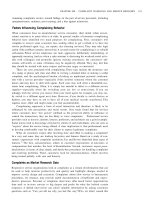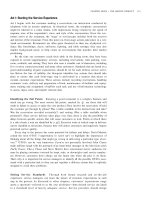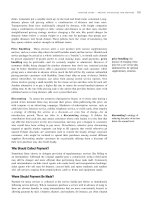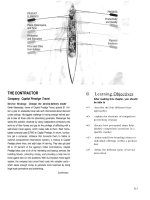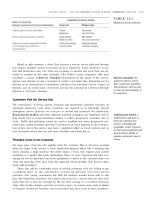Principles of cost analysis and management allocate single cost pool to users
Bạn đang xem bản rút gọn của tài liệu. Xem và tải ngay bản đầy đủ của tài liệu tại đây (490.24 KB, 42 trang )
Allocate Single Cost Pool to Users
Principles of Cost Analysis and
Management
© Dale R. Geiger 2011
1
Have you ever been here?
© Dale R. Geiger 2011
2
Terminal Learning Objective
• Task: Allocate Single Cost Pool to Users
• Condition: You are a cost advisor technician with access
to all regulations/course handouts, and awareness of
Operational Environment (OE)/Contemporary
Operational Environment (COE) variables and actors.
• Standard: with at least 80% accuracy
• Explain how poor cost information encourages undesired
behaviors
• Calculate driver rate
• Calculate proportion
© Dale R. Geiger 2011
3
A Broad Definition of Managerial Costing
raw accounting data
managerial
costing
translation
managerially useful information
© Dale R. Geiger 2011
4
Why Is This Translation Needed?
• Accounting Systems usually measure input or
source costs
• Labor, overhead, materials
• Salaries, benefits, supplies, contracts
• Managers want measurements based on
output or consumption
• Product, service, project
• Consuming organization, customer
© Dale R. Geiger 2011
5
Managerial Costing Terms
cost pool
raw accounting data
managerial
costing
translation
=
managerially useful information
© Dale R. Geiger 2011
method
of
distribution
cost
cost object
object
6
Terminology
• Cost pool:
• An aggregation of incurred or
source costs to be distributed
cost pool
• Examples:
• Salary and benefits, supplies,
travel, etc. in an airfield
operations center
• Utility bills for a garrison
© Dale R. Geiger 2011
7
Terminology
• Method of distribution:
• The mechanics of deriving
management information from
the cost pool
• Example:
• Determine unit cost by
adding all input costs and
dividing by
number of units
© Dale R. Geiger 2011
method
of
distribution
8
Terminology
• Cost Object:
• A view of cost needed by
management
• Examples:
• 120mm tube product cost
• Morale, welfare, recreation cost
• Armor school cost
cost
cost object
object
© Dale R. Geiger 2011
9
What is Allocation?
• Allocation:
• A method of distribution that
distributes cost pool to cost
objects in the same
proportion as cost driver
• Example:
allocation
based on
cost driver
• Distributing the cost of utilities
to occupants in the same
proportion as space occupied
© Dale R. Geiger 2011
10
The Mechanics of Allocation
allocation
based on
cost driver
• Allocation is a basic
technique of activity
based costing (ABC)
• Becoming an expert
is required but easy
• Allocation mechanics
excel spreadsheet
makes it even easier
© Dale R. Geiger 2011
11
Two Allocation Methods
• Rate Method:
• Uses a computed rate per driver unit
• Proportion Method:
• Computes a proportional share of the total cost
based on driver usage
• Both Methods
• Yield same results
• Represent the same underlying algebra
© Dale R. Geiger 2011
12
Reconciling the Two Methods
Rate
Method
Total Cost Pool
* Number of Driver Units Used
Total Number of Driver Units
Equals
Proportion
Method
Number of Driver Units Used
Total Number of Driver Units
* Total Cost Pool
Equals
Number of Driver Units Used * Total Cost Pool
Total Number of Driver Units
© Dale R. Geiger 2011
13
Reconciling the Two Methods
Rate
Method
Total Cost Pool
* Number of Driver Units Used
Total Number of Driver Units
Equals
Proportion
Method
Number of Driver Units Used
Total Number of Driver Units
* Total Cost Pool
Equals
Number of Driver Units Used * Total Cost Pool
Total Number of Driver Units
© Dale R. Geiger 2011
14
Split the Dinner Check
Chez Paris
Carol
Fillet and Lobster
Chicken Kiev
Top Sirloin
Caesar Salad
Coffee 2 @1.00
House Wine 4 @5.00
Champagne
Ice Cream
Chocolate Cheesecake
Sampler
Soup/Salad
Aperitif
Total
35.00
15.00
20.00
9.00
2.00
20.00
24.00
4.00
6.00
10.00
8.00
7 .00
Alice
$160.00
Thank You
Bob
© Dale R. Geiger 2011
Ted
15
Identifying Key Information
• What is the cost pool?
• The dinner check of $160
• What are the cost objects?
• Bob, Carol, Ted and Alice
• What is the cost driver?
• Number of persons (or eaters)
© Dale R. Geiger 2011
16
Identifying Key Information
• What is the cost pool?
• The dinner check of $160
• What are the cost objects?
• Bob, Carol, Ted and Alice
• What is the cost driver?
• Number of persons (or eaters)
© Dale R. Geiger 2011
17
Identifying Key Information
• What is the cost pool?
• The dinner check of $160
• What are the cost objects?
• Bob, Carol, Ted and Alice
• What is the cost driver?
• Number of persons (or eaters)
© Dale R. Geiger 2011
18
Identifying Key Information
• What is the cost pool?
• The dinner check of $160
• What are the cost objects?
• Bob, Carol, Ted and Alice
• What is the cost driver?
• Number of persons (or eaters)
© Dale R. Geiger 2011
19
Allocation Mechanics.xls
Enter the Name of the Cost Pool to be Allocated here:
dinner check
0
Enter the Total Cost of dinner check here:
$
160
Enter the Names of the Cost Objects here:
Bob
Ted
Carol
Alice
0
?
Enter the Name of the Cost Driver here:
Reset
© Dale R. Geiger 2011
eaters
0
20
Allocation by Rate Method
• First, calculate the driver rate:
Total cost pool
Total driver units
Cost pool =
$160
Total driver units = 4 eaters
Rate =
$40/eater
© Dale R. Geiger 2011
21
Allocation by Rate Method
• First, calculate the driver rate:
Total cost pool
Total driver units
Cost pool =
$160
Total driver units = 4 eaters
Rate =
$40/eater
© Dale R. Geiger 2011
22
Allocation by Rate Method
• First, calculate the driver rate:
Total cost pool
Total driver units
Cost pool =
$160
Total driver units = 4 eaters
Rate =
$40/eater
© Dale R. Geiger 2011
23
Allocation by Rate Method
• Second, multiply by driver units used by each
cost object:
•
•
•
•
•
Bob = 1 eater * $40/eater = $40
Carol = 1 eater * $40/eater = $40
Ted = 1 eater * $40/eater = $40
Alice = 1 eater * $40/eater = $40
What if Bob and Carol are a couple and Bob is
paying for them both?
© Dale R. Geiger 2011
24
Allocation by Rate Method
• Second, multiply by driver units used by each
cost object:
•
•
•
•
•
Bob = 1 eater * $40/eater = $40
Carol = 1 eater * $40/eater = $40
Ted = 1 eater * $40/eater = $40
Alice = 1 eater * $40/eater = $40
What if Bob and Carol are a couple and Bob is
paying for them both?
© Dale R. Geiger 2011
25





